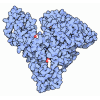+ Open data
Open data
- Basic information
Basic information
| Entry | Database: PDB / ID: 4mgd | ||||||
|---|---|---|---|---|---|---|---|
| Title | Crystal structure of hERa-LBD (Y537S) in complex with HPTE | ||||||
 Components Components |
| ||||||
 Keywords Keywords | HORMONE RECEPTOR / ligand-binding domain of nuclear hormone receptor | ||||||
| Function / homology |  Function and homology information Function and homology informationlabyrinthine layer morphogenesis / positive regulation of transcription from RNA polymerase II promoter by galactose / regulation of thyroid hormone receptor signaling pathway / positive regulation of female receptivity / regulation of epithelial cell apoptotic process / antral ovarian follicle growth / G protein-coupled estrogen receptor activity / regulation of branching involved in prostate gland morphogenesis / NR1H2 & NR1H3 regulate gene expression to control bile acid homeostasis / RUNX1 regulates transcription of genes involved in WNT signaling ...labyrinthine layer morphogenesis / positive regulation of transcription from RNA polymerase II promoter by galactose / regulation of thyroid hormone receptor signaling pathway / positive regulation of female receptivity / regulation of epithelial cell apoptotic process / antral ovarian follicle growth / G protein-coupled estrogen receptor activity / regulation of branching involved in prostate gland morphogenesis / NR1H2 & NR1H3 regulate gene expression to control bile acid homeostasis / RUNX1 regulates transcription of genes involved in WNT signaling / RUNX1 regulates estrogen receptor mediated transcription / regulation of toll-like receptor signaling pathway / nuclear estrogen receptor activity / hypothalamus development / prostate epithelial cord arborization involved in prostate glandular acinus morphogenesis / male mating behavior / epithelial cell proliferation involved in mammary gland duct elongation / prostate epithelial cord elongation / epithelial cell development / negative regulation of smooth muscle cell apoptotic process / uterus development / mammary gland branching involved in pregnancy / vagina development / TFIIB-class transcription factor binding / cellular response to Thyroglobulin triiodothyronine / steroid hormone receptor signaling pathway / androgen metabolic process / Synthesis of bile acids and bile salts / cellular response to estrogen stimulus / mammary gland alveolus development / estrogen response element binding / Synthesis of bile acids and bile salts via 27-hydroxycholesterol / Mitochondrial unfolded protein response (UPRmt) / Endogenous sterols / Synthesis of bile acids and bile salts via 7alpha-hydroxycholesterol / nuclear receptor-mediated steroid hormone signaling pathway / nuclear retinoid X receptor binding / response to retinoic acid / progesterone receptor signaling pathway / Nuclear signaling by ERBB4 / Transcriptional regulation of brown and beige adipocyte differentiation by EBF2 / cellular response to hormone stimulus / histone H4K16 acetyltransferase activity / histone H3K56 acetyltransferase activity / histone H3K23 acetyltransferase activity / histone H2AK5 acetyltransferase activity / histone H2AK9 acetyltransferase activity / histone H2BK5 acetyltransferase activity / histone H2BK12 acetyltransferase activity / histone H3K4 acetyltransferase activity / histone H3K27 acetyltransferase activity / histone H3K36 acetyltransferase activity / histone H3K122 acetyltransferase activity / histone H3K18 acetyltransferase activity / histone H3K9 acetyltransferase activity / histone H3K14 acetyltransferase activity / histone H4K5 acetyltransferase activity / histone H4K8 acetyltransferase activity / histone H4K12 acetyltransferase activity / Recycling of bile acids and salts / RNA polymerase II preinitiation complex assembly / histone acetyltransferase / estrous cycle / NR1H3 & NR1H2 regulate gene expression linked to cholesterol transport and efflux / protein localization to chromatin / estrogen receptor signaling pathway / negative regulation of canonical NF-kappaB signal transduction / positive regulation of adipose tissue development / steroid binding / : / 14-3-3 protein binding / lactation / Regulation of lipid metabolism by PPARalpha / TFAP2 (AP-2) family regulates transcription of growth factors and their receptors / peroxisome proliferator activated receptor signaling pathway / TBP-class protein binding / regulation of cellular response to insulin stimulus / nitric-oxide synthase regulator activity / positive regulation of nitric-oxide synthase activity / positive regulation of neuron differentiation / cerebellum development / BMAL1:CLOCK,NPAS2 activates circadian expression / negative regulation of miRNA transcription / SUMOylation of transcription cofactors / Activation of gene expression by SREBF (SREBP) / ESR-mediated signaling / positive regulation of DNA-binding transcription factor activity / hippocampus development / transcription coregulator binding / response to progesterone / transcription corepressor binding / nuclear receptor binding / RNA polymerase II transcription regulatory region sequence-specific DNA binding / nuclear estrogen receptor binding / negative regulation of DNA-binding transcription factor activity / stem cell differentiation / SUMOylation of intracellular receptors / cellular response to estradiol stimulus / mRNA transcription by RNA polymerase II / Heme signaling Similarity search - Function | ||||||
| Biological species |  Homo sapiens (human) Homo sapiens (human) | ||||||
| Method |  X-RAY DIFFRACTION / X-RAY DIFFRACTION /  SYNCHROTRON / SYNCHROTRON /  MOLECULAR REPLACEMENT / Resolution: 1.9 Å MOLECULAR REPLACEMENT / Resolution: 1.9 Å | ||||||
 Authors Authors | Delfosse, V. / Grimaldi, M. / Bourguet, W. | ||||||
 Citation Citation |  Journal: Environ.Health Perspect. / Year: 2014 Journal: Environ.Health Perspect. / Year: 2014Title: Structural and functional profiling of environmental ligands for estrogen receptors. Authors: Delfosse, V. / Grimaldi, M. / Cavailles, V. / Balaguer, P. / Bourguet, W. | ||||||
| History |
|
- Structure visualization
Structure visualization
| Structure viewer | Molecule:  Molmil Molmil Jmol/JSmol Jmol/JSmol |
|---|
- Downloads & links
Downloads & links
- Download
Download
| PDBx/mmCIF format |  4mgd.cif.gz 4mgd.cif.gz | 118.2 KB | Display |  PDBx/mmCIF format PDBx/mmCIF format |
|---|---|---|---|---|
| PDB format |  pdb4mgd.ent.gz pdb4mgd.ent.gz | 89.8 KB | Display |  PDB format PDB format |
| PDBx/mmJSON format |  4mgd.json.gz 4mgd.json.gz | Tree view |  PDBx/mmJSON format PDBx/mmJSON format | |
| Others |  Other downloads Other downloads |
-Validation report
| Arichive directory |  https://data.pdbj.org/pub/pdb/validation_reports/mg/4mgd https://data.pdbj.org/pub/pdb/validation_reports/mg/4mgd ftp://data.pdbj.org/pub/pdb/validation_reports/mg/4mgd ftp://data.pdbj.org/pub/pdb/validation_reports/mg/4mgd | HTTPS FTP |
|---|
-Related structure data
| Related structure data | 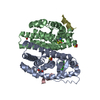 4mg5C 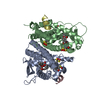 4mg6C  4mg7C  4mg8C  4mg9C  4mgaC  4mgbC 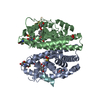 4mgcC  3uudS S: Starting model for refinement C: citing same article ( |
|---|---|
| Similar structure data |
- Links
Links
- Assembly
Assembly
| Deposited unit | 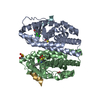
| ||||||||
|---|---|---|---|---|---|---|---|---|---|
| 1 |
| ||||||||
| Unit cell |
|
- Components
Components
-Protein , 2 types, 2 molecules AB
| #1: Protein | Mass: 29054.217 Da / Num. of mol.: 1 / Fragment: ligand binding domain (UNP residues 302-552) / Mutation: Y537S Source method: isolated from a genetically manipulated source Source: (gene. exp.)  Homo sapiens (human) / Gene: ESR, ESR1, NR3A1 / Plasmid: pET32a / Production host: Homo sapiens (human) / Gene: ESR, ESR1, NR3A1 / Plasmid: pET32a / Production host:  |
|---|---|
| #2: Protein | Mass: 29070.217 Da / Num. of mol.: 1 / Fragment: ligand binding domain (UNP residues 302-552) / Mutation: Y537S Source method: isolated from a genetically manipulated source Source: (gene. exp.)  Homo sapiens (human) / Gene: ESR, ESR1, NR3A1 / Plasmid: pET32a / Production host: Homo sapiens (human) / Gene: ESR, ESR1, NR3A1 / Plasmid: pET32a / Production host:  |
-Protein/peptide , 1 types, 2 molecules FG
| #3: Protein/peptide | Mass: 1591.880 Da / Num. of mol.: 2 / Fragment: coactivator peptide SRC-1 (UNP residues 686-698) / Source method: obtained synthetically / Source: (synth.)  Homo sapiens (human) / References: UniProt: Q15788 Homo sapiens (human) / References: UniProt: Q15788 |
|---|
-Non-polymers , 4 types, 226 molecules 

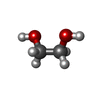




| #4: Chemical | | #5: Chemical | ChemComp-GOL / | #6: Chemical | ChemComp-EDO / | #7: Water | ChemComp-HOH / | |
|---|
-Details
| Has protein modification | Y |
|---|
-Experimental details
-Experiment
| Experiment | Method:  X-RAY DIFFRACTION / Number of used crystals: 1 X-RAY DIFFRACTION / Number of used crystals: 1 |
|---|
- Sample preparation
Sample preparation
| Crystal | Density Matthews: 2.01 Å3/Da / Density % sol: 38.85 % |
|---|---|
| Crystal grow | Temperature: 291 K / Method: vapor diffusion, hanging drop / pH: 7.75 Details: 340 mM sodium chloride, 100 mM HEPES, 24% PEG3350, pH 7.75, VAPOR DIFFUSION, HANGING DROP, temperature 291K |
-Data collection
| Diffraction | Mean temperature: 100 K |
|---|---|
| Diffraction source | Source:  SYNCHROTRON / Site: SYNCHROTRON / Site:  ESRF ESRF  / Beamline: ID29 / Wavelength: 0.97934 Å / Beamline: ID29 / Wavelength: 0.97934 Å |
| Detector | Type: DECTRIS PILATUS 6M / Detector: PIXEL / Date: Oct 22, 2011 |
| Radiation | Monochromator: liquid nitrogen cooled channel-cut Si(111) / Protocol: SINGLE WAVELENGTH / Monochromatic (M) / Laue (L): M / Scattering type: x-ray |
| Radiation wavelength | Wavelength: 0.97934 Å / Relative weight: 1 |
| Reflection | Resolution: 1.9→46.534 Å / Num. obs: 37978 / % possible obs: 99.1 % / Observed criterion σ(F): 0 / Observed criterion σ(I): 0 / Redundancy: 3.4 % / Rsym value: 0.085 / Net I/σ(I): 8.53 |
| Reflection shell | Resolution: 1.9→1.95 Å / Redundancy: 3.4 % / Mean I/σ(I) obs: 2.34 / Num. unique all: 2756 / Rsym value: 0.439 / % possible all: 99.4 |
- Processing
Processing
| Software |
| |||||||||||||||||||||||||||||||||||||||||||||||||||||||||||||||||||||||||||||||||||||||||||||||||||||||||
|---|---|---|---|---|---|---|---|---|---|---|---|---|---|---|---|---|---|---|---|---|---|---|---|---|---|---|---|---|---|---|---|---|---|---|---|---|---|---|---|---|---|---|---|---|---|---|---|---|---|---|---|---|---|---|---|---|---|---|---|---|---|---|---|---|---|---|---|---|---|---|---|---|---|---|---|---|---|---|---|---|---|---|---|---|---|---|---|---|---|---|---|---|---|---|---|---|---|---|---|---|---|---|---|---|---|---|
| Refinement | Method to determine structure:  MOLECULAR REPLACEMENT MOLECULAR REPLACEMENTStarting model: PDB ENTRY 3UUD Resolution: 1.9→46.534 Å / SU ML: 0.29 / σ(F): 2 / Phase error: 26.11 / Stereochemistry target values: ML Details: THE PRESENCE IN THE ASYMMETRIC UNIT OF TWO ESTROGEN RECEPTOR MOLECULES WITH DISTINCT PATTERNS OF SIDE CHAIN MODIFICATION REPRESENTS THE BEST FIT TO THE ELECTRON DENSITY AND IS NOT DERIVED ...Details: THE PRESENCE IN THE ASYMMETRIC UNIT OF TWO ESTROGEN RECEPTOR MOLECULES WITH DISTINCT PATTERNS OF SIDE CHAIN MODIFICATION REPRESENTS THE BEST FIT TO THE ELECTRON DENSITY AND IS NOT DERIVED FROM THE CO-CRYSTALLIZATION OF TWO CHEMICALLY DISTINCT PROTEINS.
| |||||||||||||||||||||||||||||||||||||||||||||||||||||||||||||||||||||||||||||||||||||||||||||||||||||||||
| Solvent computation | Shrinkage radii: 0.95 Å / VDW probe radii: 1.2 Å / Solvent model: FLAT BULK SOLVENT MODEL / Bsol: 63.147 Å2 / ksol: 0.345 e/Å3 | |||||||||||||||||||||||||||||||||||||||||||||||||||||||||||||||||||||||||||||||||||||||||||||||||||||||||
| Displacement parameters |
| |||||||||||||||||||||||||||||||||||||||||||||||||||||||||||||||||||||||||||||||||||||||||||||||||||||||||
| Refinement step | Cycle: LAST / Resolution: 1.9→46.534 Å
| |||||||||||||||||||||||||||||||||||||||||||||||||||||||||||||||||||||||||||||||||||||||||||||||||||||||||
| Refine LS restraints |
| |||||||||||||||||||||||||||||||||||||||||||||||||||||||||||||||||||||||||||||||||||||||||||||||||||||||||
| LS refinement shell |
|
 Movie
Movie Controller
Controller




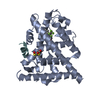



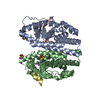

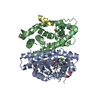
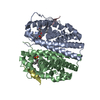

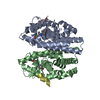
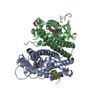
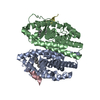
 PDBj
PDBj









